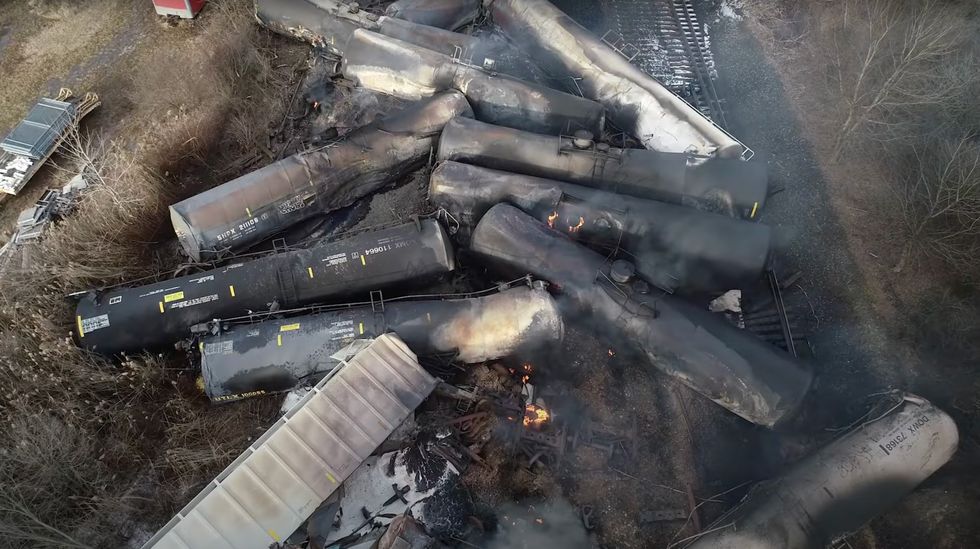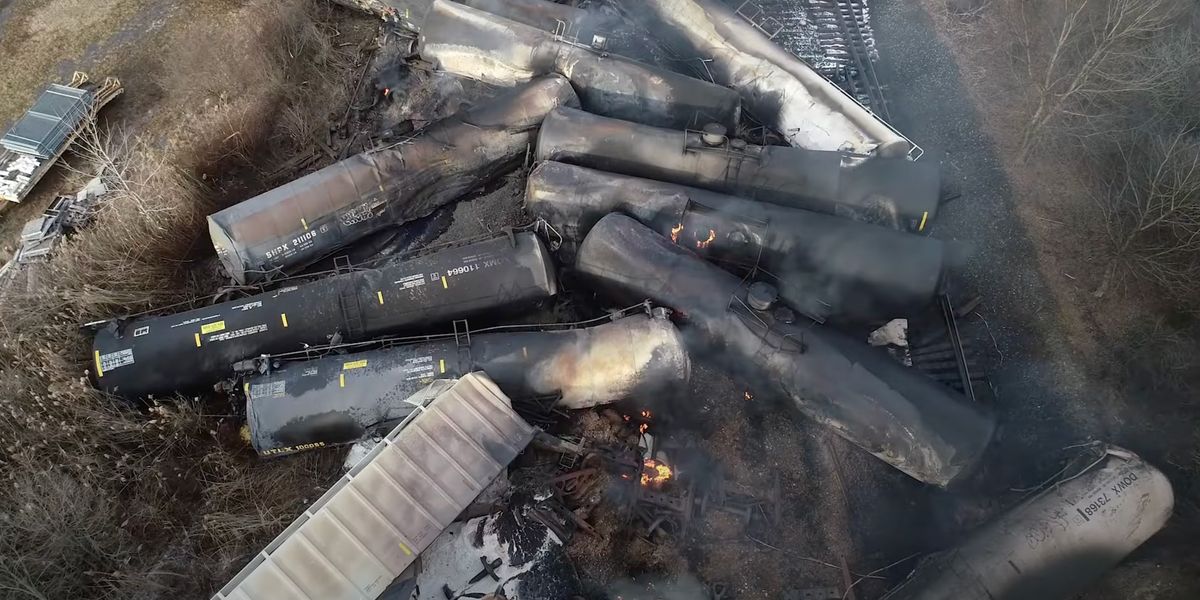
Federal investigators on Thursday released a highly anticipated preliminary report about the February 3 derailment of a train carrying hazardous materials in East Palestine, Ohio, where residents are now worried about health and environmental effects.
Norfolk Southern Railway’s (NS) train 32N featured two head-end locomotives, a distributed power locomotive, and 149 railcars—20 of which were transporting combustible liquids as well as flammable liquids and gas, including vinyl chloride.
Thirty-eight cars derailed, including 11 containing hazardous materials “that subsequently ignited, fueling fires that damaged an additional 12 non-derailed railcars,” according to the new National Transportation Safety Board (NTSB) report. Amid fears of an explosion, crews conducted a “controlled venting of the five vinyl chloride tank cars.”
While the release of hazardous materials and its short- and long-term impacts on residents and the region have garnered national attention—and the U.S. Environmental Protection Agency this week ordered Norfolk Southern to pay for cleaning up contaminated soil and water—the NTSB’s four-page report has put focus on a potential cause of the derailment: a wheel bearing failure.
Citing Allan Zarembski, director of the Railway Engineering and Safety Program at the University of Delaware, The Washington Post reported Thursday that “an overheated bearing is perhaps the most common cause of a failed axle in a derailment.”
“In recent years,” the newspaper added, “railroads—including Norfolk Southern—have added sensors on tracks that measure the temperature of bearings to determine whether overheating could pose a derailment risk.”
Train 32N, which Norfolk Southern workers say they knew was unsafe, passed three hot bearing detector (HBD) systems—designed to detect overheating and provide audible real-time warnings to crews—before it derailed, the NTSB report says. At milepost 79.9, the suspect bearing from car 23 was 38°F above ambient temperature; at milepost 69.01, it was 103°F; at milepost 49.81, it was 253°F.
NS crews are supposed to stop and inspect potential problems when alerts indicate that there is “a difference between bearings on the same axle greater than or equal to 115°F,” or there is a bearing between 170°F and 200°F, the publication notes. If the recorded temperature is greater than 200°F, the instruction is to “set out” the railcar.
In this case, the HBD system at milepost 49.81 “transmitted a critical audible alarm message instructing the crew to slow and stop the train to inspect a hot axle,” the document details. “The train engineer increased the dynamic brake application to further slow and stop the train. During this deceleration, an automatic emergency brake application initiated, and train 32N came to a stop.”
“After the train stopped, the crew observed fire and smoke and notified the Cleveland East dispatcher of a possible derailment,” the report continues. “With dispatcher authorization, the crew applied handbrakes to the two railcars at the head of the train, uncoupled the head-end locomotives, and moved the locomotives about 1 mile from the uncoupled railcars. Responders arrived at the derailment site and began response efforts.”
In addition to outlining the evidence collected from the scene, the NTSB document stresses that the investigation is ongoing:
Investigators examined railroad equipment and track conditions; reviewed data from the signal system, wayside defect detectors, local surveillance cameras, and the lead locomotive’s event recorder and forward-facing and inward-facing image recorders; and completed interviews. NTSB investigators identified and examined the first railcar to derail, the 23rd railcar in the consist. Surveillance video from a local residence showed what appeared to be a wheel bearing in the final stage of overheat failure moments before the derailment. The wheel bearing and affected wheelset have been collected as evidence and will be examined by the NTSB. The vinyl chloride tank car top fittings, including the relief valves, were also removed and examined by the NTSB on scene. The top fittings will be shipped to Texas for testing under the direction of the NTSB.
The Brotherhood of Locomotive Engineers and Trainmen (BLET) national president Eddie Hall said in a statement Thursday that the union has been assisting the NTSB in its investigation, which will continue, and though an agreement with the board limits some of what he can say today, the former locomotive engineer wanted to emphasize a few points not included in the report.
“First, we were very fortunate this time that there were three crew members on this train,” Hall said. “They were able to respond to the emergency, uncouple the locomotives from the train cars, and take other action. If this had been a train operated by one crew member it may have taken longer to react to the fire caused by the failure of the bearings, axles, and other mechanical items. It’s not unusual for things to go wrong on trains and sometimes many things. This is why it is important to have experienced engineers and conductors onboard. But, despite running ever longer trains that routinely carry hazardous materials, railroad CEOs have pushed for having only one person on the train and to even use remotely-operated trains. This is a serious mistake.”
“Second, the railroads and their trade association, the Association of American Railroads (AAR), employ armies of lobbyists on Capitol Hill who are there not to promote safety regulations but to slow the implementation of federal safety regulations or attempt to eliminate them altogether. Over the past two decades, they have spent nearly a half billion dollars lobbying Congress,” he continued. “In the absence of federal requirements, it’s important to note that the railroads will continue to self-regulate.”
“The railroads have opposed any government regulation on train length; they have sought waivers to eliminate having trained inspectors monitor rail cars; and they have pushed back on the train crew staffing rule,” he added. “Already, the AAR and the railroads are pushing back against attempts to learn from this derailment… Now is the time to toughen regulations on America’s railroads to keep both railroad workers and the communities our members operate through safe.”
The report was put out as U.S. Transportation Secretary Pete Buttigieg visited East Palestine—the day after an appearance there from former President Donald Trump, who is seeking the GOP’s 2024 presidential nomination and whose administration rolled backback Obama-era rail safety regulations.
Buttigieg’s trip to the Ohio town also followed the Tuesday release of a U.S. Department of Transportation’s plan to hold rail companies accountable and protect workers and affected communities—a plan which, as Common Dreams reported, has “too many holes,” according to Railroad Workers United.
Politico noted that Buttigieg on Thursday morning addressed why he had not visited the town sooner.
“What I tried to do is balance two things: My desire to be involved and engaged and on the ground—which is how I’m generally wired to act—and my desire to follow the norm of Transportation secretaries, allowing NTSB to really lead the initial stages of the public-facing work,” he said. “I’ll do some thinking about whether I got that balance right, but I think the most important thing is first of all making sure the residents here have what they need.”
This post has been updated with comment from the BLET.




